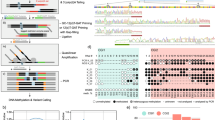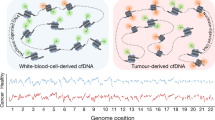Abstract
Restriction fragment length polymorphism (RFLP) of the L-myc gene was examined in DNAs from primary tumour tissues and peripheral blood cells (PBC) of 76 Indian patients with squamous cell carcinoma of the oral cavity, and PBC from 101 normal healthy volunteers. The patients and the normal healthy volunteers were classified into three genetic types according to the polymorphic patterns defined by the two alleles (6.6 kb, S fragment; and 10.0 kb, L fragment). DNA isolated from the PBC of each patient always exhibited the same pattern of L-myc alleles as that observed for the corresponding tumour DNA. However, a striking correlation was found between the RFLP pattern and the stage of differentiation of the tumours, as well as the size of the tumour. Thus, a preponderance of the S fragment was observed in the poor to moderately differentiated tumours and the larger (greater than 4 cm) sized tumours. Further, analysis of L-myc RFLP with the clinical pattern of the malignancy showed no significant correlation with nodal metastasis, TNM staging or recurrence of the tumour. The relative ratios of the three genotypes (L-L, L-S, S-S) in the oral cancer patients were not significantly different from those seen in the healthy Indians, implying no predisposition to oral cancer by either allele. However, our results showed that oral cancer patients with a genotype including an S fragment are more likely to develop a poor to moderately differentiated tumour or a larger tumour than a patient without an S fragment. The L and S alleles were equally distributed in the population, with the frequency of each allele being 0.50, consistent with Hardy-Weinberg's law.
This is a preview of subscription content, access via your institution
Access options
Subscribe to this journal
Receive 24 print issues and online access
$259.00 per year
only $10.79 per issue
Buy this article
- Purchase on Springer Link
- Instant access to full article PDF
Prices may be subject to local taxes which are calculated during checkout
Similar content being viewed by others
Author information
Authors and Affiliations
Rights and permissions
About this article
Cite this article
Saranath, D., Panchal, R., Nair, R. et al. Restriction fragment length polymorphism of the L-myc gene in oral cancer patients. Br J Cancer 61, 530–533 (1990). https://doi.org/10.1038/bjc.1990.119
Issue Date:
DOI: https://doi.org/10.1038/bjc.1990.119
This article is cited by
-
Changes in expression of oncogenes and TP53 tumour suppressor gene as biomarkers in head and neck cancers
European Archives of Oto-Rhino-Laryngology (2011)
-
Increased Frequency of the S-allele of the L-myc Oncogene in Breast Cancer
Molecular Medicine (2002)
-
Restriction fragment length polymorphism of the L-myc gene is not a prognostic factor in bladder cancer patients
British Journal of Cancer (1999)
-
MYC oncogenes and human neoplastic disease
Oncogene (1999)
-
Oncogens in ENT and head and neck — a review
Indian Journal of Otolaryngology and Head & Neck Surgery (1998)



